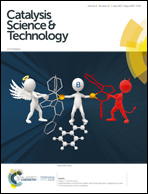Static phase transfer catalysis for Williamson reactions: Pickering interfacial catalysis†
Abstract
Pickering interfacial catalysis (PIC) systems are regarded as an innovative platform for the design of efficient static biphasic catalytic reactions. In this study, a static PIC system with high catalytic activity was constructed for a phase transfer catalysis system for the Williamson reaction. Silica particles modified with a cation surfactant, DTAB (dodecyl trimethylammonium bromide), were used as the Pickering emulsifier, and a stable Pickering emulsion was constructed. The droplet size of the emulsion was 21 μm, and no changes in the size and distribution were observed upon standing the emulsion for 24 h. Because of the competitive adsorption of DTA+ between the silica particles and phenolate anion, the second layer of DTA+ adsorbed on the modified particles is in the form of ion-pairs with phenolate anion, and the ion-pairs can also enter the first layer. These modified silica particles are arranged at the interface of the aqueous phase and the oil phase, and the adsorbed DTA+ can transfer phenolate anion to catalyze the PTC reaction. Tetrabutylammonium bromide (TBAB) can be used as a cocatalyst to enhance the catalytic reaction. The conversion rate of benzyl bromide derivatives reached more than 90% within the PIC system, demonstrating its potential applications in industrial synthesis.



 Please wait while we load your content...
Please wait while we load your content...